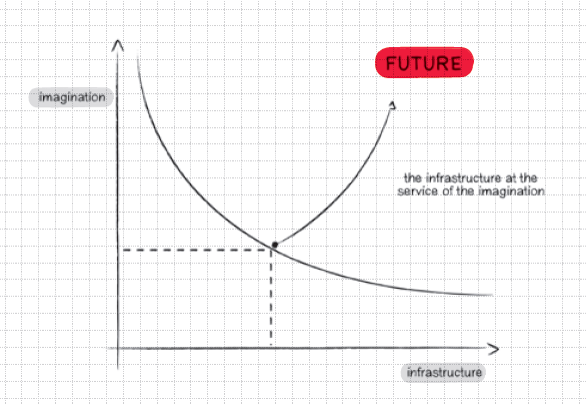
The future as a product of imagination and infrastructures
Some years ago I had a very interesting conversation with Michael
Schrage10. According to him, the future of cities was in the
“shrewd” combination of imagination and infrastructure. Often, he
told me, a city has plenty of imagination but no infrastructure, or
good infrastructure with no imagination. The difficulty lies in finding
a city that combines, in equal measures, the imagination of its people
(“its creative class”, in the words of Richard Florida) and its deployment
of infrastructure (understood in its widest sense, formed by
mechanisms to facilitate the movement of everything: energy, parts,
people, ideas, etc).
This concept can be applied to any information body, such as a person,
an organisation, a city or a nation. In the case of a business, the
tension between imagination and infrastructure is the typical tension
between people and procedure. But this is also the tension between
ingenuousness (thinking “why not?”) and engineering (thinking “how
can I do it better?”). Or between exploration (what new aspects of the
service/product can be developed in response to tomorrow’s opportunities?)
and exploitation (how to make the most of already colonised
spaces in the market to expand today’s results).
In the case of people, the tension is between creativity and preparation.
In other words, between my ability to think beyond what is
already known, and my knowledge of a specific field. And again, the
problem with people is that they are either very creative or very professional
(sic), and those with both qualities are truly rare.
As for cities, the question is how to put the infrastructure (places to
operate and mechanisms to move people and things) at the service of
ideas (more than merely at the service of daily operations or the city’s
own status).
What I want is a creative city (imagination) in which we can develop
solid new prospects (infrastructure).
This graph helps us to determine a possible trajectory of balance (as
though it were a diagram of a change of state): start from a good
infrastructure that will stimulate the imagination of the business or
the territory, so that it comes together with its latent imagination,
and both variables evolve in sync. That means to better define what
infrastructure is necessary to rouse the imagination: an infrastructure
that responds to the requirements of the imagination and is not
merely there. The crucial thing about the graph is that it puts imagination
and infrastructure at the same level. Imagination (innovation
potential) is not a whim of the moment, but an economic variable as
critical as the stock of capital and procedures (infrastructure).
From my book Visionomics.



